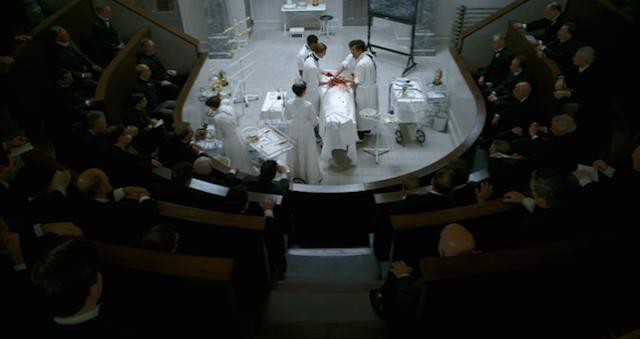The Ways in Which White People Talk Over Music
by Johannah King-Slutzky

If you want to scream whiteness, almost nothing beats rap-talk-singing — that half-monotone half-melodic vocal technique you may recognize from the likes of Beck’s “Loser” or many recent commercials. These days, rap-talk-singing is typically parody in the vein of Sir Mix-A-Lot’s famous “Baby Got Back” intro. (You know: “Becky, look at her butt. It is sooooo big. She looks like one of those rap guys’ girlfriends.”) It is not always clear when white people rap-talk-sing self-deprecatingly. Perhaps this is what happened to Taylor Swift, whose most recent single, “Shake It Off,” is somewhere between a great Gap ad and a bad pop song.
Although “Shake It Off” is aesthetically bad, even T-Swift knows that in most cases, if you are white, you must address your bad rap through irony, calling yourself out for your failure to achieve authentic blackness. Around 2:30, Taylor does just that by dressing up, first in a snapback with an oversized boombox (her black persona intro), then as a bouncy-haired cheerleader, icon of whiteness. She is going to rap-talk-sing her way to the Billboard Top 40: “My ex-man brought his new girlfriend, she’s like oh my god…” You can hear the echoes of Sir Mix-A-Lot. This is different from her attempts at rap, which are also parodic, but have never jumped directly from thug-persona irony to the exaggerated strutting and lilt of a white cheerleader.
Rap-talk-singing is as white as it gets, but it doesn’t have to ironize or foil blackness. White people rap-talk-singing pre-dates hip hop by seventy years, with roots in German opera and melodrama. The proper name for rap-talk-singing is sprechstimme, sometimes used interchangeably with sprechgesang, the latter of which is a little more melodic. Encyclopedia Brittanica defines sprechstimme as “a cross between speaking and singing in which the tone quality of speech is heightened and lowered in pitch along melodic contours indicated in the musical notation.” As a vocal technique, sprechstimme was popularized by Arnold Schönberg in his 1912 melodrama, Pierrot Lunaire. Although today “melodrama” applies to anything from Douglas Sirk films to pulp fiction, it originally referred more specifically to quasi-operas whose texts were spoken rather than sung, which is exactly what Pierrot Lunaire does. The notation for sprechstimme resembles that of singing, with precise pitch and duration, but the end effect should resemble speech first, song second. Or at least, so Schönberg said — apparently, the performance of his melodrama by its original singer, Albertine Zehme, did not match his expectations, and Schönberg repeatedly revised descriptions of his technique over the course of thirty years. Regardless, the end-product sounds something like this, starting at around the 1:11 mark:
This is still a far cry from the rap-talk-singing of today. Sprechstimme took its next step forward with another German drama, Kurt Weilland Bertolt Brecht’s Aufstieg und Fall der Stadt Mahagonny, which (if Kurt Weill, Bertolt Brecht, and Lotte Lenya are not enough for you), The Doors made famous as “Alabama Song (Whiskey Bar).” As you can see, early performances were quite flat (go to around 9:04).
This flatness, the source of the song’s appeal, was quite deliberate. Brecht actually devised “Alabama Song” as a full-bodied melody, but Weill altered it by shifting some of the emphases and razing the pitch to a sprechstimme. (Weill’s teacher at the Berlin Hochschule für Musik, Engelbert Humperdinck, contends that he is the inventor of sprechstimme, which he employed in his 1897 opera Königskinder.) Although using a different notation system, Weill’s opera, like Schönberg’s, specifies spoken intonation down to the sharps and flats.
Skipping ahead a half century, sprechstimme continued to be unrelentingly white without being faux- or anti-hip hop in Paul Simon’s under appreciated classic, “Pigs, Sheep and Wolves.” The name alone! It may not be a classic as measured in prestige, but it is certainly vintage Paul Simon, who spends just under four minutes chuckling in sing-song about picaresque barnyard animals just as, elsewhere, he rhapsodizes on Puerto Rican immigrants and college bound killers. Although Simon’s aesthetic is pre-hip hop (and thus pre-hip-hop irony), “Pigs, Sheep and Wolves” is just about the whitest song I’ve ever heard.
Paul Simon’s sprechstimme shares a few things with Taylor Swift’s: It is silly, it is parodic. Perhaps this is just what sprechstimme is — recursion from melody to flat sing-song as a kind of indirect speech act. Although the contexts of the vocal technique have changed significantly in the last century, using sprechstimme to denote a strange speaker is nothing new. Michael Von der Linn’s article on sprechstimme for Columbia University’s Sonic Glossary notes that in the early twentieth century, “The unique sound of Sprechstimme was often used to represent emotional duress, the macabre, even madness.” Today, we don’t use sprechstimme to signal madness, but to parody strange speakers. And there is still the madness of depression, for which, for example, Beck employed sprechstimme in the 1993 alt rock hit, “Loser.”
As in “Pigs, Sheep and Wolves,” you see the same kind of indirect quotation in yet another popular example of rap-talk-singing, Bikini Kill’s “Rebel Girl,” whose first lines are written in parodic indirect speech before they give way to the unabashed, sincere position of the more melodic song proper: “That girl, thinks she’s the queen of the neighborhood. She’s got the hottest trike in town…” Without being named explicitly, sprechstimme has become a hallmark of riot girrrl — it is even in Russian punk — and of Kathleen Hanna’s bands in particular. “Rebel Girl”’s gurlesque intro is particularly interesting because it fills one of the gaps between something like “Pigs, Sheep and Wolves,” which is white and parodic but not a foil to hip hop’s blackness or masculinity, and Taylor Swift’s anti-hip hop rap-talk-singing.
In a post-hip hop world, sprechstimme tends to take the form of the anti-hip hop, white girls with bad agendas. Parody, unseriousness, and quotation are rampant. But rap-talk-singing needn’t exclusively be a foil to authentic hip hop, although it is unsurprising it has taken this form in the last twenty years.
Johannah King-Slutzky is a blogger and essayist from New York City.
Journalism Funded

What happens in Ferguson and the St. Louis metro area the day after everybody leaves?
I’m not sure.
We plan to be there as it all unfolds.
Great. I feel better knowing that AOL, a large, profitable media company, supports the Huffington Post’s real, on-the-ground reporting.
For The Huffington Post, this’ll involve a first-of-its-kind collaboration with readers, the local community and the Beacon Reader to create what we’re calling the Ferguson Fellowship.
Oh wow, I love it when the community gets involved.
Local resident Mariah Stewart has been covering the Ferguson protests as a citizen journalist with the support of readers through Beacon’s platform. With HuffPost readers’ support, we can make sure Stewart can continue her work.
I’m happy to support her! What do I retweet?
Click here to make a contribution and to learn more about Stewart and the Ferguson Fellowship.
Wait.
In partnership with The Huffington Post, your backing can train and fund a promising new journalist in Ferguson for the next year.
What?
For the first time, you have the power to ensure on-the-ground coverage from Ferguson remains a part of the national conversation. The first Ferguson Fellow, Mariah Stewart, has already made an impact with her coverage on Beacon. But she can do even more with training, guidance, and support from The Huffington Post. To enable this, we’re aiming to crowdfund at least $40,000 for 12 months of coverage plus benefits.
But can’t AOL, a large, sprawling media company that owns a lot of things that generate a lot of revenue, find the money somewhere? I mean, it paid three hundred and fifteen million dollars for the Huffington Post, millions of which Arianna Huffington, who has been tweeting about Ferguson a lot, personally received? Why can’t the Huffington Post, an organization once valued at nearly a billion dollars, just like, hire Mariah Stewart, who seems like a nice person?
After the first year, we’ll continue the fellowship if interest remains.
Will we have to pay for that, too?
Brand Citizens United

That my shampoo, lunch, toilet paper and vitamins may have been discussed in a single company’s annual meeting is something I both take for granted and otherwise bury as deeply as possible. It’s bizarre and uncomfortable: Conglomerate brand ownership makes for good trivia and bad thoughts.
The consumer conglomerates themselves don’t usually hide, exactly. General Mills isn’t worried that people will be shocked to discover that Hamburger Helper and Lucky Charms share a parent company. But Clorox doesn’t go out of its way to remind shoppers that Liquid-Plumr, Burt’s Bees and KC Masterpiece trade under the same ticker symbol. And you don’t see AB InBev posters in your local beer section, which stocks dozens of its local-seeming brands. People either have to find this out themselves, by looking it up, or make gradual inferences from grouped supermarket coupon deals. Otherwise these things are left unspoken.
Which is what makes Procter & Gamble’s New York ad campaign, “New York Tough,” especially strange.
This week, on one subway car, I saw “#NYStrong” ads for Febreeze, Bounty, Dawn and Crest, each with the “[BRAND] is tougher” construction. They did not say, in any easily visible way, “Procter & Gamble.” They were just there, unapologetically related in an unspecified way.
Crest toothpaste is #NYTOUGH. NEVER FORGET. pic.twitter.com/IVpYfBSwJc
— Teddy Wayne (@TeddyWayne1999) July 17, 2014
The first implication is: these products are made by the same company. The second: we no longer care that you know, this is a fact of modern capitalism, stop being a baby. I only saw a portion of the ad buy, apparently. There are similar ads around New York for Head & Shoulders, Pantene, Secret and Tide:
Ms. Erdahl is willing to say that it is “the first time we’ve done” a campaign of this kind, and it was inspired by the fact that “New Yorkers are among the most resilient and adaptable people you can find.”
“We aim to provide effective and efficient solutions to the everyday challenges New Yorkers face,” she says, which inspired the contents of the ads.
It’s a targeted campaign in that it makes jokes about specific New York neighborhoods, the smells and matter and character of which these products are equipped to deal with. It’s also a much broader advertisement against the idea that consolidated ownership — of the stuff that cleans your mouth, your floor, your dishes, your dog’s bed — is notable at all.
Premium Gore

The first episode of Steven Soderbergh’s The Knick, which is streaming for free, is worth watching just for the street scenes in turn-of-the-century New York. It’s a nasty, crowded place, but the shots aren’t overstuffed and bustling — the show knows it has time, so it doesn’t feel the need to introduce you to every rag peddler and slumlord at once. In this way, it is not like a movie.
Here is how The Knick is like a movie: It’s beautiful, and it’s totally disgusting. The Knick is possibly the most visually arresting show in TV, not only for its setting but for its portrayal of the human body, inside and out, intact and ripped apart. Among its closest aesthetic competition is NBC’s Hannibal, which is equally organ-obsessed: The Knick’s camera lingers on primitive surgeries intended to save people; Hannibal’s lingers on bizarre surgeries intended to cause suffering.
Most of the acclaimed/new-golden-era/sad-people/big-money TV shows are formally gorgeous. Mad Men’s sets and actors are carefully arranged and filmed with vivid detail, and the fantasy world of Game of Thrones is as completely rendered as anyone could want. But these shows keep going and going — there are about forty hours of GoT — which has the odd effect of numbing the audience to their visual mastery. A single frame captured in Westeros might contain a dozen costumes, a CGI beast, ugly people and stunning people, an enormous castle. At first this is stunning, and it stays that way for a while. Eventually the big set pieces start to feel the same. You expect them, and they fade into the background.
The same could be said of the show’s other dependable source of novelty, its constant violence. Swords plunge into bodies and big brutes slash away at villagers and after a while you just start to tune out. Then someone’s head literally explodes, and the camera doesn’t cut away, and everyone is reminded they’re watching PREMIUM gore, on HBO. (The Walking Dead has become a sort of weekly splatter film: A queasy and conflicting blowoff valve for people who like to watch human-ish creatures get killed in new ways, in the loose context of a story, before they start their workweeks).

Dexter ran into this problem and more or less gave up on violence-as-art (and, eventually, almost everything else that made it interesting). The Knick and Hannibal sidestep desensitization and reclaim shock by taking the camera inside the body. Soderbergh knows that a deliberate incision in a quiet operating theater is so much more effective — and repulsive! — than full bodily destruction on a battlefield. The Knick’s surgery scenes revolve around the patient, his or her parts, and the flimsy instruments that are cutting into them. It doesn’t pay much mind to the people performing the surgery — their chattering and panicking and narrating is an accompaniment to the removal of a fetus, or the administration of the an experimental spinal anaesthesia. The camera zooms as close to action as it can without losing its place in the room entirely.
This is new, mostly! There have been plenty of gory shows on TV recently — The Walking Dead, True Blood, Bones, American Horror Story — but none of them are quite as visually innovative, or polished, or narratively dependent on blood. All violent shows, especially the better ones, are not easily situated on the cable/premium “appropriateness” spectrum. Hannibal isn’t less gory than The Knick — you may get a closer look at Clive Owen’s slashing and cutting, but it’s all at least notionally medical and meant to save. Hannibal Lecter kills people to eat them, and to make them suffer. He puts their bodies on display and the camera scans every detail. We watch him arrange their body parts into food, and then we watch him watch other people eat it. (The Knick is afforded the option of nudity by Cinemax, which it takes advantage of immediately, as if to say “hello, this is not AMC.”) But the moral taxonomy of television channels — network, cable, premium — barely seems to take violence into consideration. A reasonable person, watching these two shows back to back, could reasonably say that Hannibal, which broadcasts over the air on the same network as America’s Got Talent, is the more graphic and disturbing of the two. (It’s also a Tumblr sensation with a young and energetic fandom that doesn’t seem to care all that much about violence.) Then again that same person might watch cable news for five minutes and conclude: This is much worse.
People will become numb to this new gore, too, and then maybe it will be easier to tease out just how good — worthy? interesting? disturbing? — these shows really are. Hannibal has mostly held up as a psychological thriller over two seasons, but its slow-motion horror tableaus don’t mesmerize and repel the same way they did during those first episodes. The Knick’s novelty could easily wear off, as we settle into the old city, get used to the electronic score, and become accustomed to the sight of flapping intestines and the noises of wet clumsy surgery.
We also haven’t seen what a knockoff premium gore show looks like. Just wait for the Playboy Club to The Knick’s Mad Men. It’ll happen! It’ll be bad. And it will make us all feel a little bit worse about enjoying the shows that came before it in the first place.
Update: Willa Paskin suggests a first entrant into the knockoff gore genre: The Following.
Off the Beaten Path: Adventures in NYC
by Megan L. Wood

Brought to you by Heineken.
In France, most of the country shuts down for the month of August as its citizens escape the heat and humidity for their annual beach vacations. In New York, most of us are lucky to have offices with air conditioning and a friend whose parents have a pool to visit on the weekends in Long Island. By the end of summer, we’re over the heat but still desperate to make the most of it before the leaves change. So what’s a jaded New Yorker to do this August other than marry a French person and adopt the best of their cultural norms? Here are some ideas for enjoying the city indoors and out:
Rooftop camping:
Do you love camping but hate the idea of schlepping upstate with all your gear? Is the roof of your building accessible? Is your landlord the absentee type? If the answer to all these questions is yes then pitch a tent on your roof and spend the night under the stars you can’t see because of light pollution. I thought I maybe invented this idea, but a quick Google search let me know that the New York Times was all over this concept last summer.
Movie theaters are obvious summer destinations because of the air conditioning and opportunity to sit in a darkened room for two hours without speaking. But sneaking in a beer isn’t as fun as a server bringing you one with an order of fish tacos, like they will at Nitehawk in Williamsburg. The theater shows new releases; cry it out with Boyhood, and curated series like naughty movies at midnight. If you love it there so much you can drink at the bar before and after films are shown.
Staycation:
This is one of the spendier items on the list, but wouldn’t it be fun to get away from your roommate for a long weekend and stay in a hotel? Split the cost with a friend at Aloft New York Brooklyn, which has available rooms in August for less than $200 a night. Crank up their air conditioning, bring your own booze, and swim in the pool with a retractable roof. Bonus: pets stay free. Double bonus, someone else will make your bed in the morning.
Shuffleboard:
Because of gentrification, Gowanus is no longer just the above ground section of the G train. Royal Palms Shuffle Board is kind of a cool hang, and a definite upgrade from bowling because you can wear your own shoes. The courts are open on a first come first served basis. Reservations are available for groups of 10 or more. Check their calendar for rad events like food truck visits and 80s night. No one under 21 allowed means no strollers and you can swear to your heart’s content without getting any dirty looks from parents. Go to the nearby, newish Whole Foods for ginger shots afterwards.
Hotel pool:
Try to talk your way into SoHo House, get rejected but insist on using the restroom. There, you’ll find the I.D. card of a British woman whose identity you will temporarily steal — allowing you to bring your three best lady friends to the rooftop pool where you will discuss body hair until staff discovers that you are not actually British. Oh man, only do that if this was 2003 and both Sex and the City and SoHo House were still relevant. Otherwise, go to La Piscine at Hotel Americano, which is open to the public after six.
Fishing charter:
Sheepshead Bay in Brooklyn has a small harbor of seaworthy vessels that take groups of amateur fisherpeople out on the water near the tip of Coney Island. A friendly/brash crew provides fishing poles, bait, advice, and plenty of innuendo about poles. You can bring aboard all the Heineken and snacks you want. If flirting with the crew and catching rays is more your thing than reeling in fish, it’s your money and you can do what you want with your time. The crew will filet any caught fish that’s legal to keep and send it home for you to eat, but, um — I wouldn’t. Make reservations online or just roll up to the harbor before noon on a Saturday. Competition for passengers is fierce between the boats; they’ll gladly make room for you and your pole. See what I did there with the pole joke?

Ladies, let’s talk. Do you know where all the men in Manhattan are? They’re practicing their swing over the Hudson River at Chelsea Piers driving range. If you have a Tinder account, it will blow up here. If you’re actually there to practice your swing, the facilities are state-of-the-art and there’s a great breeze off the river with views of New Jersey. Waits for a space can be long, but there’s a full bar and a fun broesque scene. Rates are cheap on Sunday nights after six. And, ah, French guys golf. Play your cards right and maybe you can spend next August in Nice like God intended. Photo: Flickr user Ben W
Looking for something different from the conventional restaurant experience? Dinner Lab is a “members-only dining club that pairs up-and-coming chefs, many of whom work on the lower rungs of top restaurants, with a hungry, adventurous fan base keen to sup at out-of-the-box locations — including a helipad, a church and a motorcycle dealership.” At Dinner Lab, locations are announced one day prior to the event, lending an air of mystery to the whole affair. Chefs are 100% in charge of the meal, cooking several courses of their most original and innovative cuisine. If you can brave the waiting list, you’ll undoubtedly eat some good grub and (and maybe meet some interesting people while you’re at it). Sign up for a seat at the table on their website.
Remember when you first moved to the City and went to awesome concerts every week? Of course you do! But eventually you became burnt out on the late nights, sweaty venues and obnoxious hecklers shouting in your ear. Fair enough. If you’re looking for an intimate, curated musical experience you can share with true music lovers, check out SoFar Sounds (short for “Sounds From a Room”). SoFar Sounds hosts small, living room performances twice a month for 100–130 New Yorkers. With an 800 person waiting list it may be a hot minute before you’re able to experience what SoFar sounds has to offer. But hey, it’s something to shoot for! You might as well go ahead and sign up today.
Watch how Heineken interrupted the routines of fellow New Yorkers in their latest social experiment “The Payphone”, starring Portlandia’s very own, Fred Armisen.
Learn more about how Heineken plans to get you to veer off the beaten path at www.routineinterruptions.com
Top Photo: Flickr user MadAbandon
Bethany Beach, Delaware, August 19, 2014

★★★★ The morning was gray and dripping, even as the information online declared that there was a zero percent chance of rain. Gradually things brightened; the deck dried out. Still there was little beach-bound foot traffic. The seven-year-old went out to blow bubbles in what was now sunshine, exhorting them to fly over the roof of the building closer to the ocean. The sea at high tide was the color of wine bottles and the color of cobalt, deep beautiful tones, and deliciously warm, and much too rough to try swimming in. Letting the breaking sandy foam rush past, waist high and above, was the least alarming way of savoring it. There was no chilly shock — it felt as if it were warmer than the air, though it couldn’t have been. The children dug in the sand and refused to go near the water. Bright white little shells emerged, their edges eroded away. At sundown the sky was crocheted with silver and purple, with the sun a big smear of wet gold paint in the west. Kites hung above the dunes, fluttering and seemingly secure there, till one plunged nose-first out of view. The breeze smelled salty. Glasses of white wine sweated on the edge of a balcony overlooking the boardwalk. The west went through various more or less lurid colors, arriving at last at scarlet.
The Lost Section

Here is a weird thing about the technology section of the most important newspaper in America: A number of its biggest stars have left in recent months. While reporters at large papers frequently move around and often change beats — especially at the Times — all of these reporters continue to cover technology, just not from the tech desk. Nick Bilton, its most famous writer, who lives in the future and watched Twitter get hatched, now runs his “Disruptions” column in the Styles section; Claire Cain Miller now covers “tech + gender/work/family” at the Times’ explainer site, the Upshot; Jenna Wortham, its brightest star, recently decamped for Sunday Business, where she continues to cover technology and culture; and it was announced the other week that David Stretfield, a Pulitzer Prize-winner for his work on the Times’ remarkable iEconomy series about Apple’s supply chain, while not technically leaving the technology desk, was taking on a “wider role as an enterprise correspondent” and would “contribute pieces to other sections of the paper, including the Sunday Magazine, and will expand his portfolio to take on topics beyond tech.”
These moves are partly because the tech desk is tightly circumscribed, in both content and form, by its placement within and subservient to the business section, a structure that, to the outside world, makes less and less sense every day. This is why other sections, in particular Styles, always free to cover whatever, have been been able to colonize the far more interesting and fertile field of cultural technology coverage at a relentless pace. (Even many of the technology section’s occasionally ambitious and captivating stories about how technology is changing how we live that truly intersect with business, like Vindu Goel’s piece on how Facebook sold us krill oil, have been published in Sunday Business.)
It’s also because the section, rather than being a natural showcase for the Times’ more technologically innovative forms of reporting, is run fairly conservatively by the current editor, Suzanne Spector, who landed the job after a Game of Thrones-like chain of events. (In January 2013, Glenn Kramon, then the Times’ assistant managing editor for enterprise, wanted to move to the West Coast to be in the same place as his partner, and was given the job of the well-liked editor Damon Darlin, who was then shipped to New York. Kramon changed his mind, but Darlin had already moved and been made the international business editor [though he’s now at the Upshot, reunited with Miller], while David Gallagher, the section’s deputy editor — assumed to have been in line for the job — had taken a lucrative gig as the head of Kickstarter’s PR after being passed over. So Kramon was replaced by Spector.)
What might seem remarkable is that that none of these four writers have left the paper. But this is less so when one considers that there aren’t that many places to go once you’ve reached the top of the weird and mostly grotesque mountain that is technology journalism, a highly warped growth produced by the collision of the tech industry and startups with enormous amounts of money and culture writ large. A number of online outlets would indeed pay any one of those writers handsomely for a whiff of the legitimacy they carry — indeed, BuzzFeeᴅ tried to purchase at least one of the four for an almost-gross sum — but those publications are off the table if one cares about good old fashioned prestige, as a Times reporter is wont to do. The newsweeklies would’ve once carried no prestige penalty, paid even better (and in-demand technology journalists are already well paid, nearly as well as business journalists), and allowed the kind of longish, roving pieces that ambitious reporters like to produce on a semi-relaxed schedule, like Steven Levy used to produce at Newsweek, but all those magazines are dead now. Bloomberg BusinessWeek is as close as it gets — and it did poach a prior generation of Times tech talent, nabbing Brad Stone, Sam Grobart and Ashlee Vance — but it has not (so far) been successful at convincing any of the current Times tech diaspora that Bloombergland is the place for them. (Not that it hasn’t tried.) Wired is nice, but essentially a beautiful, massively successful trade magazine (and besides, they just promoted very-deserving Awl pal Mat Honan to Steven Levy’s old spot, along with newcomer Jessi Hempel, following Levy’s decampment to Medium). The luxurious GQ or Vanity Fair contributing editor contract is harder than ever to come by. There is the New Yorker, which has been covering technology and startup culture particularly feverishly — and while Michael Specter, Ken Auletta, Nathan Heller, and Lizzie Widdicombe have cycled through the Valley recently, some more successfully than others, the magazine does lack the technology equivalent of, say, a Dexter Filkins. But one can’t just wait around for a job there.
So the Times is lucky in a way: a Dome of Privilege has descended upon it, and it gets to keep some of the most celebrated technology reporters around, improving the technology coverage in individual sections, for now. (And it has certainly made some solid hires in the wake of all these departures, like technology’s favorite dad, Farhad Manjoo, and its least favorite toilet paper mascot, Mike Isaac.) But at a time when things like government surveillance, book publishing, Hollywood, climate change, gentrification, food production, a million other topics are all technology stories in non-trivial ways, the Times might want to ask itself if it’s ready to finally rethink what it means by technology coverage, if only to set a better example for everyone else. Maybe the Upshot can make an infographic about it.
Polly Asks: New York Magazine Wants Me to Write Ask Polly For Them. Should I Tell Them to Piss Off?

Dear Readers,
I need to tell you a story. That means this will be just like every other Ask Polly column, except this story is a little longer than usual, and at first, when you read it, you’ll ask, “Where’s the tepid dude of the week?” Just bear with me.
In September of 2012, after reading and admiring The Awl for years, and writing a few short humor pieces for them, I sent Choire Sicha an email.
Subject: Existential advice column
That’s what I should be writing for The Awl.
Come on, pay me a tiny bit and it’s yours! Just enough $ so my husband doesn’t roll his eyes and spit whenever he hears the word “Awl.”
Choire’s one-word reply was:
DONE.
Two days later, I sent in my first column and The Awl published it, and thus began one of the best gigs of my career. My first editor, Carrie Frye, let the term “pious fuckwinder’ run in my second column. My second editor, Choire, was even more tolerant of dubious strings of adjectives. (He also once forgot to pay me for five months, but when I responded with a three-thousand-word screed on the madness of freelance writing, he sent me a check and published my screed and paid me for that, too.) My third editor, Matt Buchanan, let the term “dickweasel” run. In a world full of pious fuckwinders and dickweasels, in other words, The Awl is an island of sanity, and originality, and humility. I had hoped to never leave.
Then three weeks ago, Stella Bugbee, the editorial director from New York Magazine’s The Cut, called me. She told me that they’ve been in the market for an advice columnist, but haven’t been able to find the right person. Apparently people want real advice, not gimmicks, she said. People want good advice from a writer with a really strong voice, she said. People want guidance from someone who’s wise and thoughtful and fair.
“Why are you talking to me, then?” I asked.
“We want you to come to The Cut,” Stella said, whose voice seemed to indicate that she dresses really well. “We’re prepared to double what you’re making.” I snorted audibly. Then I multiplied my current rate by two and wrote it down on a nearby piece of paper. Hmm, not exciting enough. So I multiplied my current rate by three and wrote that down. Then I multiplied it by four, then five, then ten…
“Hello?” Stella said.
“I don’t know,” I said, staring at the largest number on the page and imagining myself on a beach in Belize, surrounded by bronzed towel boys serving fruity drinks in hollowed-out coconuts. I pictured other bronzed towel boys arriving with huge platters of aged cheeses and soft cheeses and fresh breads and cured meats. “Eduardo, I said Cambozola, not Gorgonzola.” “I’m so sorry, Miss Heather.”
“Are you still there?” Stella asked.
“I love The Awl so much,” I said. This came out quite naturally, because I wasn’t lying like I usually am when people ask me how I like my current employer.
Stella proceeded to tell me more about The Cut, how they don’t just write about breastfeeding and sixteen super-sexy summer styles. They cover a wide range of topics, and it’s very writer-driven, just like the rest of New York Magazine’s empire. She said some other stuff, but by that point I was so deep in a Belizian towel boy fantasy I sort of lost the thread. “So what’s it going to take?” she asked.
“I like aged cheeses a lot,” I said. “And they’re pretty expensive. But I don’t want to change the column, You know what Ask Polly is: It’s four thousand words, half of which are variations on ‘fuck’ and ‘motherfucker.’”
Stella sighed. Her lips sounded so glossy.
“You would retain full creative control.” Creative control, yes, I thought. The bronzed towel boys came back to mind.
So I got off the phone to talk to my husband, who looked disappointingly unbronzed and wasn’t carrying a towel or an array of soft cheeses.
“People will think I’m a sell out!” I told him. “That’ll be refreshing, for people to imagine me doing something that someone actually pays me for.”
“What’s a sell out?” my husband asked. (I guess people don’t use that term anymore.) “Does that mean you’ll make some fucking money for a change? Because that would be fucking awesome,” he said.
“But it’s a fashion and beauty website. People will think I dress better than I actually do!” I said. “That’ll be cool, for people to imagine that I’m not just some dipshit who bumbles around the house in soft pants all day. I wonder if they’ll imagine me in white linen…”
“White linen? Like Don Johnson used to wear on ‘Miami Vice’?” my husband said, who would never sass back to me like that if I made more money.
So I emailed Choire. I thought he might be really angry or BEREFT at the thought of losing Ask Polly, but instead he was very nice and said it would be crazy for me not to seize a great opportunity, and that The Awl is all about nurturing young writers with cool ideas and letting them fly and be free when they move on to bigger things.
“I’m not actually young,” I replied. “I’m older than you.”
“Lol,” he wrote back. (Did he think I was joking?)
“I really am older than you,” I wrote back.
“OMG, I hate olds! Lol!” he replied.
Anyway. As someone who, generally speaking, hates change, I know this might not sound like great news to some of you who read the column every week. But I think it’s a great opportunity for Ask Polly to reach more people, and a great opportunity for me to give the column more of my attention instead of squeezing it in between other gigs. (No, I didn’t get Belizian towel-boy money; this is still an online magazine we’re talking about, and not the Sultanate of Brunei.) New York Magazine is run by smart people and employs some of my favorite writers. I’ve been assured that they don’t want to change Ask Polly at all, and they intend to nurture and support the column for the long haul.
Writing this column has been much more rewarding than I’d ever dreamed it would be when I first pitched the idea to Choire on a whim. I’ve gone from getting one or two letters each week to getting ten to twenty letters every single week, without fail. I love writing the column. I don’t want to stop doing this anytime soon.
I’m not a big believer in gushing about your love for your readers. But Ask Polly readers are pretty fucking special, let’s face it. We have a few things in common, maybe. A certain kind of stubbornness that’s often misinterpreted as a bad attitude. A certain kind of skepticism that’s often misinterpreted as contempt. We are unique snowflakes who sometimes feel uniquely fucked, even when we can recognize, intellectually, that our experiences might just be universal. We are sensitive flowers who act tough anyway. We are damaged goods who remain optimistic — in spite of having spent a little more time in the half-priced bin than was good for our tattered egos.
I’ll publish my last Ask Polly column on The Awl next week at the usual time, which is also the same day that my first column will appear on The Cut. I hope you’ll join me over there, among the glossy-lipped and the snappily dressed. The habitat might look a little shinier, and you might be simultaneously repulsed and turned on by headlines that say things like “Yoga For Swoll Hunks.” But I’ll still be offering up the same digressive opinions and pious fuckwindery you’ve come to expect from me.
Whatever happens next, though, please keep on telling the truth and sticking your necks out. Good things come to those who are brave enough to show the world exactly who they are, without shame. And look, soon enough, you can be sure that someone will give this owning-of-your-flaws an embarrassing name, in the hopes that we’ll all get shamed back into the closet and go back to believing that every misstep and mistake should be airbrushed out or masked behind a smile and a high five.
Let’s not let them shame us, though, ok? Let’s keep on fumbling along, imperfectly, with pride, with grace, with humility, with an open heart. Let’s be messy and courageous, you and me and all of us. Let’s not be afraid to ask for exactly what we want, and to celebrate exactly who we are, and to eat lots of aged cheeses if possible. But most of all, let’s stick together and celebrate our messiness, and our courage.
Polly
Heather Havrilesky (aka Polly Esther) was The Awl’s existential advice columnist. She’s also a regular contributor to The New York Times Magazine, and is the author of the memoir Disaster Preparedness (Riverhead 2011). She blogs here about scratchy pants, personality disorders, and aged cheeses.
Photo by itchys
Questions We Ask the Oldest People

Can you imagine reading a story like this about yourself?
A 111-year-old retired Japanese educator who enjoys poetry has been recognized as the world’s oldest living man…
Asked how he felt about the record, Momoi pushed his back upright and said he wants to live longer.
“Say, another two years,” he said.
Momoi said he enjoys reading books, especially Chinese poetry, and sometimes practices calligraphy.
He said there is no special trick for his longevity, but his caregivers say Momoi keeps early hours and eats healthy, according to NHK public television.
It’s always the same pattern with these wire stories:
Oldest person, do you think you have long left?
I hope so, like most other people I do not want to die.
Oldest person, what are your hobbies?
I have some, I wish I had started more. I wish I had started a lot of things.
Oldest person, what is your secret?
Sleep, eating well. Do those count as secrets? Surely not. My friends did these things too and they are all gone, now.
You were alive during [war] and [major event in world history], and before [technology].
Yes.
Oldest person, thank you for your time, my job is done and yours is too. I’ll talk to your family right after you die!
Thank you, too. Now I must reckon, privately and in public, with the fact that I am the oldest man on Earth and still know nothing.
I think I would skip my turn, if possible.
